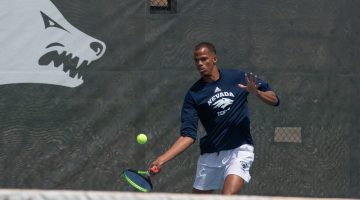
Photo provided by NASA
Hubble highlighted the Bubble Nebula, or NGC 7635, to mark the 26th anniversary of the Hubble
Space Telescope’s launch into orbit. During the past few decades, the telescope has been used to
create hi-definition images of the deepest observed regions of the universe.
By Marcus Lavergne
There are few mysteries that come close to reaching the level of o b s c u r i t y behind how h u m a n i t y got here and where it all started. The cosmos’s behavior and origin have intrigued the world’s most renowned intellectuals since the beginning of civilization, but with the help of developing telescopic technology, scientists are working to peer into the depths of time, back to where it all began.
Dr. Robert Williams has been interested in the realm of astronomy since he was 12 years old. Through his research, he’s constantly pushed the limits of his lifelong fascination with the mysterious, ever-expanding vacuum known as outer space.
Williams, an adjunct professor at Johns Hopkins University and former director of the Space Telescope Science Institute has worn many hats, but for him, observing the cosmos as an astronomer has been one of his most rewarding endeavors.
Last Thursday, three days before the 26th anniversary of the Hubble Space Telescope’s launch into orbit, Williams spoke to a large group during his lecture, “Hubble Space Telescope: Piecing Together the Workings of the Universe,” in the University of Nevada, Reno’s Davidson Math and Science Center’s Redfield Auditorium. The lecture focused on Hubble’s past, present and future as well as the future of space observation and theories on the structure of the universe and its expansion.
Williams, presently Astronomer Emeritus for the STScl, played a significant role in shaping the Hubble Space Telescope Program into what it is today — an effort dedicated to viewing the furthest depths of space, which contains the origin of the known universe. Williams was the Director for the STScl from 1993 to 1998 when he was awarded the American Astronomical Society’s Beatrice M. Tinsley Prize for his leadership in piecing together the Hubble Deep Field.
The HDF is a collection of 342 separate exposures that revealed what were then the furthest-observed regions of the universe during its unveiling in 1996. The telescope peered through space and time, more than 10 billion years in fact, into areas where some galaxies were still undergoing the formation process.
“The Hubble Deep Field, which enabled us to look back in this pencil beam, this core sample, back that far and see galaxies in various stages of formation was a real turn-on,” Williams said.

Marcus Lavergne/Nevada Sagebrush
Dr. Robert Williams answers questions involving space observation inside the Davidson Math and Science Redfield Auditorium on Thursday, April 21. Williams is an astronomer who has worked with both NASA and the Space Telescope Science Institute.
Williams and his colleagues were able to create the most recent representation of the universe after improving the tools on the Hubble Telescope. NASA and the STScl pushed things another step further in 2004 when they disclosed the Hubble Ultra Deep Field, a visual sample of a universe that was only around 400 million years old. The estimated 10,000 galaxies shown range between 800 million to 1 billion years old.
For Williams, that’s another step in the right direction. Discoveries made through the Deep Fields and the recent discovery of gravitational waves, or ripples in the fabric of spacetime, have made for some of Williams’ most exciting days as an astronomer. However, other days that are packed with quiet observation and waiting during uncontrolled experiments also have their importance.
“All of this is fascinating stuff, but it occurs over a long timescale,” Williams said. “I wouldn’t say that there’s a whole lot of excitement, but it’s like building something. Every once in a while you find a problem, and when you solve that small problem that can be exciting.”
Williams’ most fulfilling days involve communicating what he does know about the cosmos to others and learning about discoveries that other scientists make. It explains his admiration of the gravitational waves detection by the twin Laser Interferometer Gravitational-wave Observatories in Louisiana and Washington state.
Discussing the future of space exploration and observation, as well as the technological advancements that come along with it is conversation fodder for Williams who’s looking forward to looking past the Ultra Deep Field.
According to Williams, a solid theory on the structure of the universe is one of the most important steps in getting past the current barriers to telescopic space observation. As an astronomer, Williams emphasizes in spectroscopy and novae or exploding stars and nebular gas clouds. It’s only fitting that Williams’ goal lies at the theoretical origin of life itself where things kicked off with a bang, the Big Bang.
“The fact that we really have for the first time have a sense of how all this is taking place, at least in the big picture, really gives us a unifying evolutionary picture of the universe,” Williams said addressing the crowd. “We don’t understand the origin of life, but we’re getting somewhat confident that we may start to understand these things in the next 10 to 20 years.”
The humanity’s role within the expansive celestial system isn’t quite clear. That being said, Williams says the picture is coming together, but these things take time and effort in addition to extensive technological development. Interestingly enough, it’s taking place in a significant way.
Hubble’s successor, the James Webb Space Telescope, is the future. The $8.8 billion device will use infrared tech to look past a conglomeration of cosmic dust clouds that Hubble can’t see past. Whatever’s behind the clouds may hold answers to just how the universe came to be and where it’s headed. The spacecraft is scheduled to launch in 2018.
Williams capped off the Discover Science Lecture series. He and other lecturers have come to the UNR throughout the year with research that dissects some of the planet’s mysteries as well as the potential truths hiding behind cosmic dust. Some people have even been able to connect many of the lecturers’ ideas to their own field of study.
At least, that’s the case for senior neuroscience major Michael Alvarado who says the series does a good job of finding lecturers who make all kinds of new information accessible.
“What I took away from this lecture in particular was even the universe is an evolutionary phenomenon,” Alvarado said. “I think that’s pretty amazing to see that on a macroscopic scale. It’s interesting to see evolution not just as a life phenomenon.”
For Alvarado, making associations between human life and understanding the universe’s multitude of mysteries is natural. He compares the brain’s neurons to tree branches and roots, and believes the connection is deeper than just structural similarity. Alvarado calls all human beings “stardust.”
Alvarado also believes that learning about the newest technology being used to form those connections and explore humanity, the planet and other celestial bodies is important.
“The most mind-blowing thing from this whole lecture is there possibly being a telescope that can look beyond the Big Bang,” Alvarado said. “Doesn’t that blow your mind, just uttering the words?”
Williams left the crowd with a message of solidarity, which means finding just where humans stand in the midst of everything happening in the universe. He touched on subjects that include the evidence of the existence of life on other planets, something he hopes scientists will find on Mars.
For now, he and his colleagues will continue trying to piece together the universe’s seemingly infinitely pieced puzzle through the lenses of powerful telescopes — devices that act as the eye of humanity, peering into, well, everything.
Marcus Lavergne can be reached at mlavergne@sagebrush.unr.edu and on Twitter @mlavergne21.









